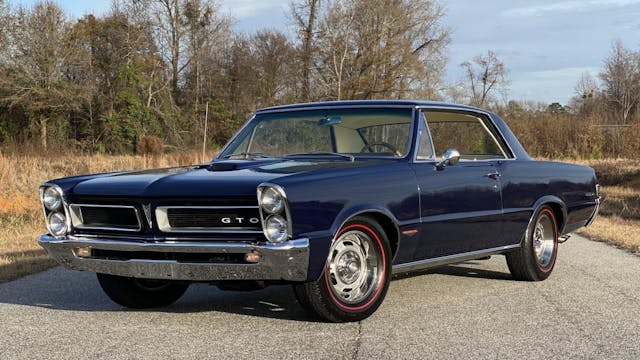Media | Articles
Many mainstream classics are finally cooling off
For much of the last 24 months, the collector car market has been on an upward charge. That’s been a boon for sellers, but the average buyer hasn’t much enjoyed watching once-attainable metal climb out of reach. At long last, that trend appears to be slowing down. Based on data from the past three months, we can still point to cars on the rise, but more than an isolated few have begun to taper off.
As any good mechanic knows, when your standard instruments aren’t giving you enough information, it’s time for deeper diagnostics. One of the key tools on our shelf are indices based on the the Hagerty Price Guide. In fact, we have seven such indices: Blue Chip, British, Ferrari, Muscle Car, Postwar German, 1950s American, and Affordable.
Each index is comprised of the movers and shakers within a specific segment. Viewing the data in this manner gives insight into the health and trajectory of a specific part of the market, much like stock market indices can help suss out trends in sectors of the economy. Indices are calculated an average of the #2 (Excellent) condition of the component vehicles and are updated quarterly, along with the price guide.
Across the board, the market is doing quite well. Of the seven indices we track, six experienced growth, with four achieving an all-time high rating. The remaining index, 1950s American Cars, remained flat.
https://datawrapper.dwcdn.net/QNMEf/1/
Marketplace
Buy and sell classics with confidence
Delving deeper into the data, though, we see that there are a number of mainstream cars that are pulling back, despite overarching gains in their respective segments. Let’s take a look:
Affordable Segment
Time to redefine “affordable”?
Hagerty’s Affordable Car Index has been the most consistent gainer of all indices. So much, so, in fact, that the term “affordable” may no longer be appropriate. Component cars like the Datsun 240Z and 1970 Camaro SS 350 were once very inexpensive cars and have since exploded in value.
These cars, however, did not drive this quarter’s overall increase. Rather, huge gains from the likes of the Volkswagen Beetle balanced out losses by cars like the ‘65 Mustang GT and the MGB. What does this tell us? Some cars are staying within reach—like the 1949 Buick Roadmaster Sedanette, or the 1972 Triumph TR6—while others are still climbing.
Playing “what if” here, had Beetles not posted such substantial gains, the Affordable Index could very well have seen its first loss since 2011. The takeaway here is that the lower echelons of the market may be softening. Caveat: It is unreasonable to expect these cars to take a big enough step back to erase the regret many of us feel at not buying a 240Z, Beetle, or a TR6 back when they were dirt cheap. But maybe some sanity is returning into the market for the collector of more ordinary means.
Middle of the market
Mixed results
Movement was a tad more subdued in the meat of the hobby. The British, Muscle Car and 50s American indices all increased by 1 percent or less. Unlike the top of the market (see below), component cars for these segments had very mixed results.
Indices like Muscle Cars and British still reached all-time highs, but the rate of increases is clearly slowing. Zooming in closer, we see that a few significant gainers made up for a number of small losses. With 1950s American cars, there was plenty of activity but the gains and losses of various models washed each other out completely.

That’s not to say the middle of the market is declining. We’d call it leveling out or, in math-nerd speak, regressing to the mean. Many of the vehicles that have softened, like ’65 Pontiac GTOs and ’70 AAR Cudas, experienced incredible growth earlier in the year.
A caveat here is that the fall is typically a quiet time for buying and selling in this price range. Muscle car acolytes in particular, may have their sights set on the January sales in Kissimmee and Scottsdale.
Top of the market
Is the stock market’s loss the collector car market’s gain?
The top of the market is clearly influenced by activity coming out of Monterey. Our Blue Chip index, which measures the performance of the top end of the Price Guide, performed exceptionally well. Over half of the 25 component cars posted gains with four cars posting gains over 10 percent. Overall, the Blue Chip Index posted a 3 percent gain for the quarter, the biggest move in a year. More segment-specific upper-end market indices, like Ferrari and German, also posted a 3 percent increase. Like with Blue Chip, the Ferrari index saw over half the component vehicles gain value, while the German index experienced more focused increases at higher rates.

To some extent, these results echo the gangbusters sales at Monterey in August. Traditionally, we see a slowdown of the top of the market subsequent to Monterey, so it should come as no surprise if these indicators level off somewhat in the fourth quarter. Yet the top of the market’s strong showing in late summer—even as other segments were softening—could also be a sign that, with inflation high and the stock market underperforming, some high-net-worth individuals see million-dollar cars as a safe (and fun) port in the storm.
Check out the Hagerty Media homepage so you don’t miss a single story, or better yet, bookmark it.













I think the younger generation will collect cars just different ones. My son who is 20 talks about how there are no “good” new cars. Because of video games like Forza and Grand Turismo he romanticizes about The late 80s early 90s 300zx, NSX, RX7, MR2, Supra, Integra, Celica, Skyline etc. My main concern is will he be able drive any of them. Will operating it be possible. Will finding gas and running a ICE car become a luxury? In my 30s and 40s I had my weekend fun car now in my 50s I have a few. 10-30 years from now when there are no new ICE cars how will it work?
Sold a lot of MGBs over the years, but still have my 240Z [never any rust] purchased in 73.
My two Morgans, a 1966 +4 & And 2003 +8 values always creep up.
What’s going to happen to driving classics when gas is so unaffordable because of the government’s war on fossil fuels?
I ordered a 1970 Dodge Challenger RT in 1969 and took delivery in January 1970 in San Jose, California. Since then I’ve worked in Chicago, Boca Raton & Ft. Lauderdale, and Atlanta. It has the Track Pack with a 440 Magnum, 4-speed and Hearst pistol grip shifter. High impact banana with black vinyl top and black interior. All numbers match. I’ve been driving it with a wide grin all these years. Steering is a bit sloppy, but it still looks great. The engine has been rebuilt a couple of times and is still strong. I might sell it at the right price, but I don’t know what that is. Any ideas?
The plural of “index” is not “indexes”, it is indices.
Apparently both are acceptable (AP writing style even requires the use of Indexes) but we have changed the article to reflect your suggestion.
Inflation, recession, consumer confidence dropping, stock market woes … interest rates up, housing market slipping, energy production down, fuel prices up… could go on and on. Look at cars for sale on facebook marketplace and see how many have reduced prices- same with bike, motorcycles, boats, rv’s.
Affordable is something too many classics are losing. For me to “afford” I will have to sell. It’s that simple now.